Best of 2018: Top 10 Art Installations

In 2018, we saw an eclectic mix of installation inspiration, but there’s no denying that humanity’s relationship with nature was a prominent theme throughout the year. Ranging from poignant to playful, these works of art prompted viewers to engage with art from an environmental perspective.
Many of the year’s top installations dealt with ocean conservation, including Jason deCaires Taylor’s short-lived “inverse zoo,” Courtney Mattison’s ceramic coral reef, and StudioKCA’s large, litter-crafted whale. Some, like Thomas Dambo’s enchanting Troll Hunt, Ernesto Neto’s crocheted canopy, and HOTTEA’s Scope Art Show installation imaginatively showed appreciation for the natural world, while HYBYCOZO creatively captured the “patterns that appear in nature” with their laser-cut sculptures.
In addition to eco-centric works of art, Culturespaces, Yayoi Kusama, and JR and immersed viewers in artwork inspired by history, human interaction, and personal memories.
Explore these spectacular installations below.
Top Pieces of Installation Art in 2018
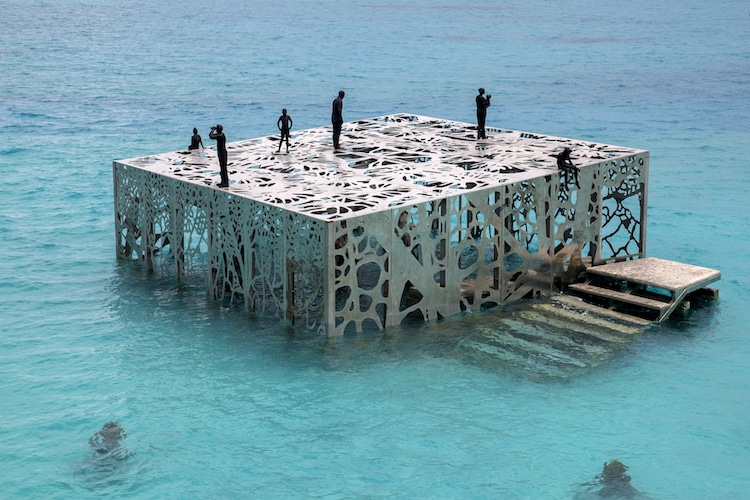
Photo: Jason deCaires Taylor and the Fairmont Maldives
Coralarium by Jason deCaires Taylor
British sculptor Jason DeCaires Taylor uses his practice to advocate for environmentalism. Time and time again, he’s wowed the world with his aquatic Earthworks, from solitary cement figures to an entire underwater museum. In 2018, Taylor added a new piece to his ambitious oeuvre: Coralarium, a submerged sculpture gallery.
Like all of Taylor’s creations, Colararium transcends its role as a work of art. Made out of punctured pH-neutral marine steel, this colossal cube doubles as an artificial reef, inviting sea creatures to swim around the structure and explore the figures dwelling in its interior.
“It’s almost like an inverse zoo,” deCaires Taylor said. “In cities, we go into space and look at caged animals. Whereas this is almost like we’re the tourists, but we’re in the cage and the marine life can come and go and look at us. It’s almost a reversal of how we interact with wildlife.”
Unfortunately, Colararium was destroyed by the Maldivian authorities in September. They deemed the piece “offensive to Islam” due to its depiction of human forms.
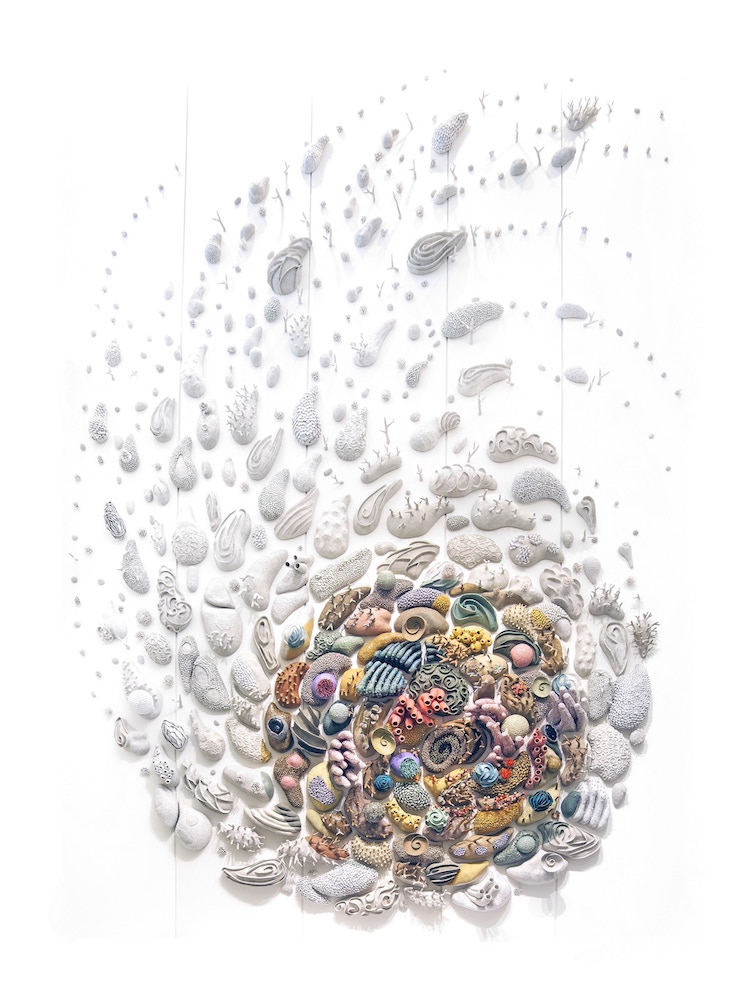
Photo: Courtney Mattison
Confluence (Our Changing Seas V) by Courtney Mattison
Artist Courtney Mattison sculpts ceramic installations that “promote awareness for the protection of our blue planet.” As a part of the Art in Embassies program, Mattison was commissioned to create Confluence (Our Changing Seas V) for the United States embassy in Jakarta, Indonesia.
Like other works in Mattison’s Confluence series, this large-scale piece comments on the fragility of the coral reef. Specifically, Confluence (Our Changing Seas V) explores the effects of coral bleaching, as it portrays a cluster of corals, anemones, and sea sponges spiraling into skeletons.
By drawing attention to this issue, Mattison hopes to promote coral conservation and encourage people to seek a solution. “It is possible for coral reefs to recover even from the point of bleaching if we unite and act quickly enough to decrease the threats we impose,” she says. “Perhaps if more people appreciate Indonesia’s spectacular reefs, we will act more wholeheartedly to preserve them for future generations.”
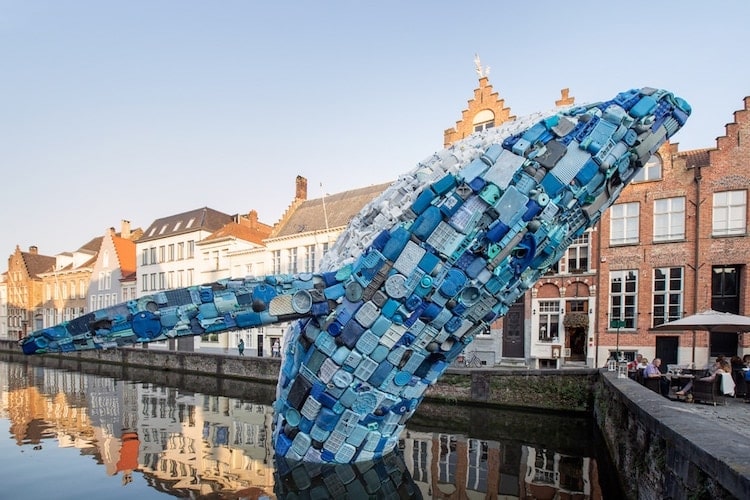
Photo: StudioKCA
Skyscraper (the Bruges Whale) by StudioKCA
For this year’s Bruges Triennial, StudioKCA and Hawaii Wildlife Fund collaborated to create Skyscraper (the Bruges Whale), a 38-foot installation. Intended to “show the scope and scale of the problem” with plastic waste, the monumental piece was crafted from 5 tons of litter fished out of the Pacific and the Atlantic Oceans.
StudioKCA opted to call the installation Skyscraper as a nod to the size of the whale. At 4 stories tall, it towers over the medieval buildings that line the Bruges Canal, making it a perfect symbol of the large-scale issue.
“A whale, breaching from the water, is the first ‘skyscraper of the sea,’ ” the artist said, “and as the largest mammal in the water, it felt like the right form for our piece to take in order to show the scope and scale of the problem.”
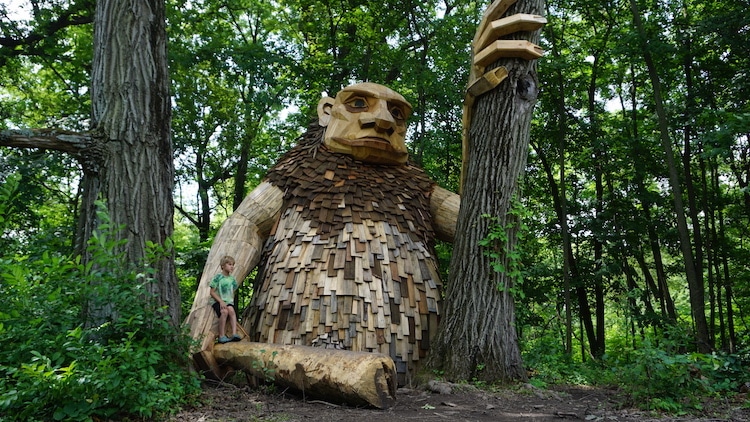
Photo: Thomas Dambo
Troll Hunt by Thomas Dambo
Troll Hunt, an installation comprising six sneaky trolls, popped up in Illinois’ Morton Arboretum over the summer. Crafted by Thomas Dambo, these peculiar figures are made out of reclaimed wood, showcasing the artist’s ability to make “anything you can imagine out of trash.”
Once assembled, these site-specific sculptures came to measure anywhere from 15 to 60 feet tall. Though massive in size, Dambo skillfully hid the crafty trolls in the arboretum, inviting guests to use their Troll Hunter’s Handbook to track them down.
Though initially slated to last only through 2018, this installation will be on-view into the new year. Depending on weather, it may even last until summer 2019.
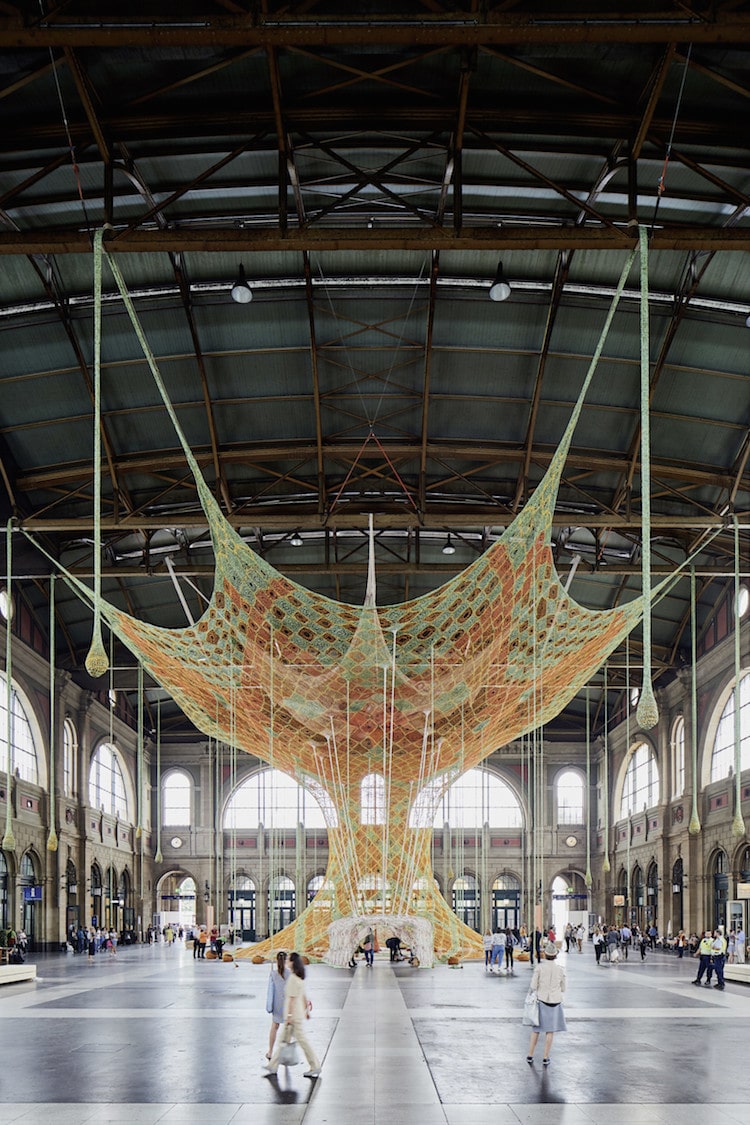
Photo: Fondation Beyeler
GaiaMotherTree by Ernesto Neto
With his large-scale installations, conceptual artist Ernesto Neto “explores constructions of social space and the natural world by inviting physical interaction and sensory experience.” In 2018, he collaborated with Fondation Beyeler to create GaiaMotherTree, a crocheted structure that took root in Zurich’s Central Station.
This immersive work invites members of the public to step inside of its draping canopy and escape the hustle and bustle of the station. Once inside, they can observe the piece from a new perspective and experience another interactive layer of the installation: smell.
The “branches” of the tree are weighted with bags of spices. As the fragrant scents of turmeric, cloves, cumin, and black pepper waft through the air, viewers are invited—and reminded—to take a deep breath. “The idea is to slow down our time, for us to have time to breathe and feel life inside of us,” the artist says. “This work is all about intimacy.”
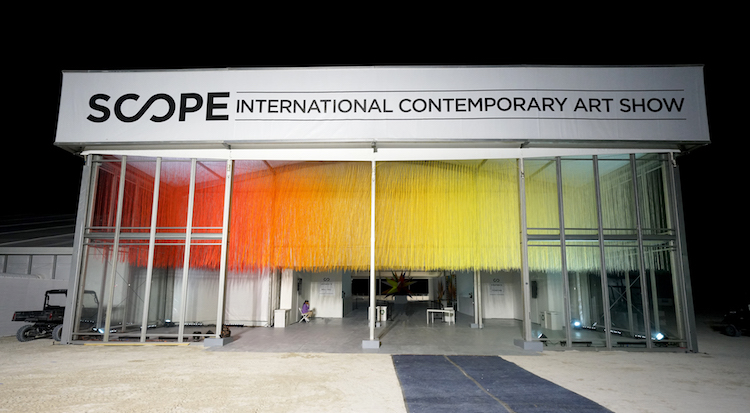
Photo: HOTTEA
SCOPE Miami Installation by HOTTEA
Eric Rieger, also known as HOTTEA, creates sentimental yarn art inspired by memory. Since foregoing his spray-paint practice for something more meaningful, the former graffiti artist has crafted a collection of vibrant fiber installations. In 2018, he created a show-stopping work of art that welcomed visitors to SCOPE Miami Beach—a popular satellite art fair in Florida—with a dazzling gradient of rainbow color.
Tasked with creating a site-specific piece that would only be on view for one week, HOTTEA was determined to design an eye-catching installation whose message would have a lasting impact. “My installation for SCOPE Miami 2018 was inspired by the idea of taking things for granted,” HOTTEA told My Modern Met. “Even though we may take things for granted, once they are gone we wish we would have acted differently. Our sun, rain, wind, plants, animals, people, everything could disappear in seconds and when they do it is our memory of them that will carry on assuming there is something beyond our existence here on earth. What I hope people took away from my installation was not only a color experience they will not forget but also a reminder of how much a singular moment can mean.”

Photo: HYBYCOZO
Installations in No Spectators: The Art of Burning Man by HYBYCOZO
Over the last few years, HYBYCOZO has taken Burning Man by storm with their installations. However, in 2018, the duo plucked their laser-cut polyhedrons from the desert and placed them in the museum for No Spectators: The Art of Burning Man.
Presented by the Renwick Gallery in Washington DC, this unique exhibition shows the work of HYBYCOZO in a new light. Three of their pieces—Inner Orbit: Lvov, Deep Thought, and Trocto—are included in this exhibition, illuminating the gallery’s walls with a dance of light and shadow.
No matter the context, HYBYCOZO hopes that all of their installations prompt “a sense of curiosity and wonder about the geometry of the shape and the meaning of the pattern” from all viewers.
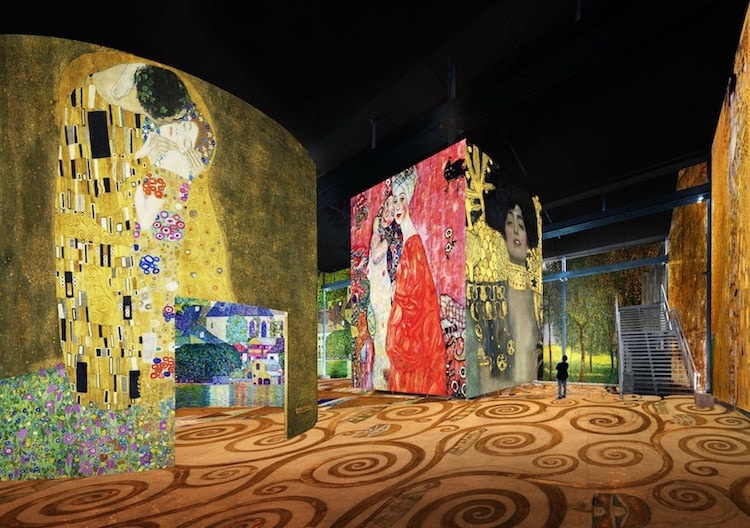
Photo: Culturespaces
Atelier des Lumières by Culturespaces
Culturespaces uses unique multimedia equipment to create and curate digital shows that “add dynamism to artistic practices, amplify emotions, and reach the largest possible audience.” This modern approach to exhibition is the driving force behind the Austrian art installation at Paris’ Atelier des Lumières.
Featuring 3,000 moving images made by 20 laser video projectors, this installation highlights the work of Viennese artists, including Egon Schiele, Friedensreich Hundertwasser, and—most prominently—Gustav Klimt.
In addition to The Kiss and other works on canvas, this exhibition features projections of Klimt’s epic Beethoven Frieze, inviting “visitors who have never had the opportunity to visit the Secession Palace in Vienna to behold the iconic figures in Klimt’s frescoes” with a technological twist.
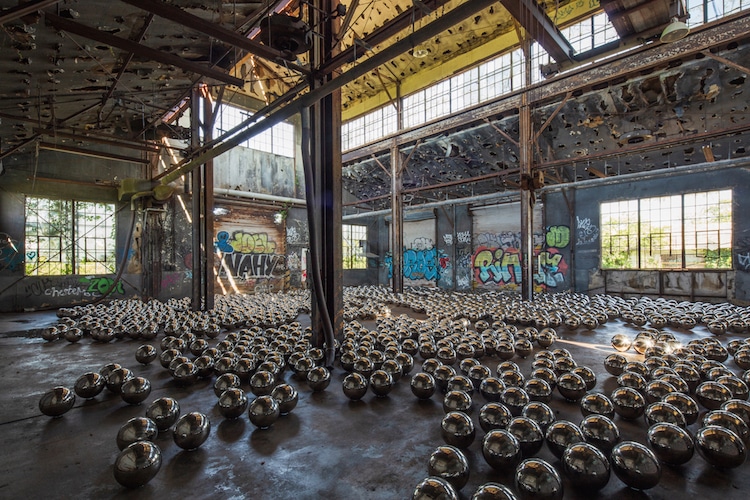
Photo: Yayoi Kusama / MoMA PS1
Narcissus Garden by Yayoi Kusama
In 1966, Yayoi Kusama debuted her first Narcissus Garden. Intended to comment on the vanity and commercialization of contemporary art, the installation featured a field of reflective spheres—an element still present in today’s iteration at MoMA PS1.
For 2018’s Narcissus Garden, Kusama filled an abandoned U.S. military base in Fort Tilden with 1,500 stainless steel, mirrored balls. Much like previous editions, the spheres are intended to draw attention to the surrounding space and prompt viewers to contextualize their own reflections within this bigger picture.
Narcissus Garden was commissioned for Rockaway!, a free public art festival founded to support the redevelopment of New York’s Rockaway Peninsula area following Hurricane Sandy in 2012.
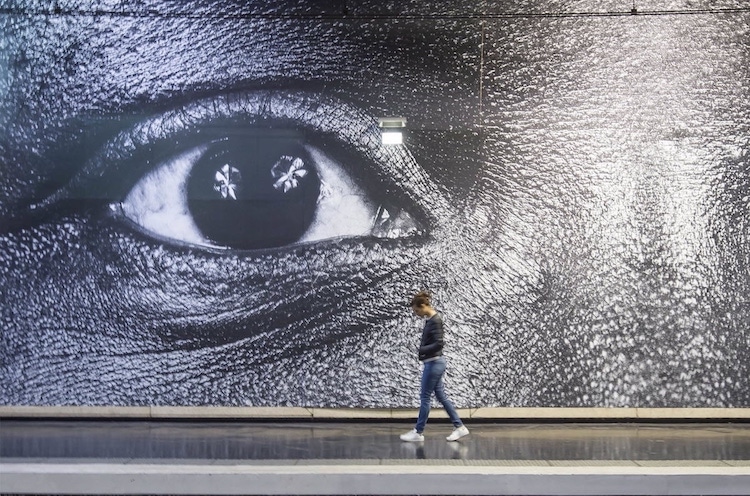
Photo: RATP
Voyage avec d’autres by JR
In 2018, the eye-catching photographs of French street artist JR invaded Paris’ railways. Commissioned by the Paris transit operation RATP, Voyage avec d’autres (“Traveling with Others“) brought a bit of art to some of the city’s most bustling sites.
For this project, JR placed monumental photographs of people’s eyes in 11 of Paris’ metro and train stations. After a few weeks or installation, JR decided to gradually replace the existing artworks with new portraits taken by the artist in the very stations they adorn.
By rotating these new photos of “people passing in front of the previous eyes” into the series, JR creatively blurs the line between subject and spectator.
Next: Best art installations of 2017.
